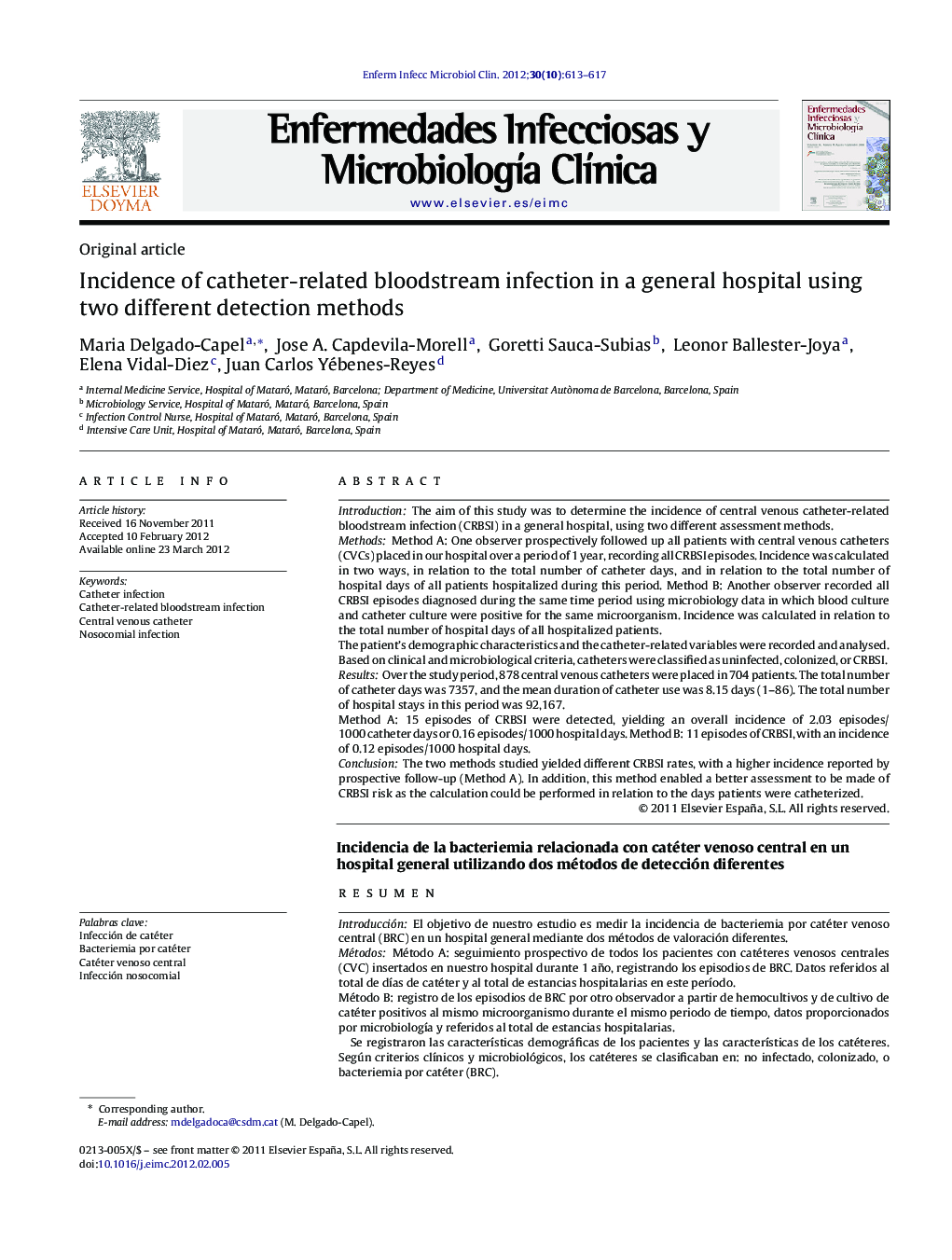| کد مقاله | کد نشریه | سال انتشار | مقاله انگلیسی | نسخه تمام متن |
|---|---|---|---|---|
| 3400897 | 1593088 | 2012 | 5 صفحه PDF | دانلود رایگان |

IntroductionThe aim of this study was to determine the incidence of central venous catheter-related bloodstream infection (CRBSI) in a general hospital, using two different assessment methods.MethodsMethod A: One observer prospectively followed up all patients with central venous catheters (CVCs) placed in our hospital over a period of 1 year, recording all CRBSI episodes. Incidence was calculated in two ways, in relation to the total number of catheter days, and in relation to the total number of hospital days of all patients hospitalized during this period. Method B: Another observer recorded all CRBSI episodes diagnosed during the same time period using microbiology data in which blood culture and catheter culture were positive for the same microorganism. Incidence was calculated in relation to the total number of hospital days of all hospitalized patients.The patient's demographic characteristics and the catheter-related variables were recorded and analysed. Based on clinical and microbiological criteria, catheters were classified as uninfected, colonized, or CRBSI.ResultsOver the study period, 878 central venous catheters were placed in 704 patients. The total number of catheter days was 7357, and the mean duration of catheter use was 8.15 days (1–86). The total number of hospital stays in this period was 92,167.Method A: 15 episodes of CRBSI were detected, yielding an overall incidence of 2.03 episodes/1000 catheter days or 0.16 episodes/1000 hospital days. Method B: 11 episodes of CRBSI, with an incidence of 0.12 episodes/1000 hospital days.ConclusionThe two methods studied yielded different CRBSI rates, with a higher incidence reported by prospective follow-up (Method A). In addition, this method enabled a better assessment to be made of CRBSI risk as the calculation could be performed in relation to the days patients were catheterized.
ResumenIntroducciónEl objetivo de nuestro estudio es medir la incidencia de bacteriemia por catéter venoso central (BRC) en un hospital general mediante dos métodos de valoración diferentes.MétodosMétodo A: seguimiento prospectivo de todos los pacientes con catéteres venosos centrales (CVC) insertados en nuestro hospital durante 1 año, registrando los episodios de BRC. Datos referidos al total de días de catéter y al total de estancias hospitalarias en este período.Método B: registro de los episodios de BRC por otro observador a partir de hemocultivos y de cultivo de catéter positivos al mismo microorganismo durante el mismo periodo de tiempo, datos proporcionados por microbiología y referidos al total de estancias hospitalarias.Se registraron las características demográficas de los pacientes y las características de los catéteres. Según criterios clínicos y microbiológicos, los catéteres se clasificaban en: no infectado, colonizado, o bacteriemia por catéter (BRC).Resultados878 CVC se colocaron a 704 pacientes. Total de días de cateterización de 7.357, y duración media de la inserción de 8,15 días (1–86). El total del número de estancias hospitalarias fue 92.167.Método A: se detectaron un total de 15 episodios de BRC. Incidencia global de BRC de 2,03 episodios/1.000 días de catéter o 0,16/1.000 estancias hospitalarias.Método B: 11 episodios de BRC, tasa de 0,12/1.000 estancias hospitalarias.ConclusiónObservamos diferencias relevantes en las tasas de BRC obtenidas según el método de valoración empleado, siendo superior el método A. Además, el seguimiento prospectivo de los pacientes cateterizados permite una mejor valoración del riesgo de BRC al referir el resultado a días de cateterización.
Journal: Enfermedades Infecciosas y Microbiología Clínica - Volume 30, Issue 10, December 2012, Pages 613–617